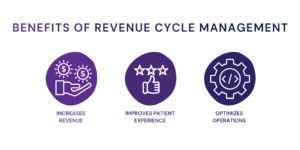Blog

Table of Contents
This article will provide a comprehensive overview of the revenue cycle management lifecycle. Revenue cycle management is an important aspect of any healthcare organization as it encompasses all the steps involved in the process of patient care and the associated financial transactions. It starts with the initial patient encounter and continues through the final payment and claims resolution.
Understanding the various stages of the revenue cycle management process is essential for healthcare organizations to optimize their financial performance and ensure the highest level of patient satisfaction. In this article, we will delve into each stage of the revenue cycle management lifecycle and the various activities involved in each stage.

What is Revenue Cycle Management?
Revenue Cycle Management (RCM) refers to the process of managing the financial transactions involved in the delivery of healthcare services to patients. The RCM process starts when a patient seeks medical services and ends when the final payment has been received, including any follow-up for claims resolution. The main goal of RCM is to ensure that healthcare providers are paid for the services they deliver in a timely and accurate manner, while also improving the patient experience. The stages of revenue cycle management include:
Pre-Registration
Pre-registration is a process that helps gather patient demographic and insurance information before the patient’s visit. This information can be used to verify the patient’s identity and insurance coverage, as well as to reduce processing time and paperwork on the day of the visit. Pre-registration is also beneficial in that it allows for accurate billing and reimbursement, which in turn increases organizational efficiency.
Registration
The first step in the registration process is to verify the patient’s information. This includes confirming their name, address, insurance information, and other relevant data. Once this is done, a financial record can be created. This record includes information about copayments, deductibles, and other charges associated with their care. Registration for a new patient is an essential part of providing quality healthcare services.
Patient Check-In
The patient check-in process is an important part of a healthcare facility. It involves confirming patient information, collecting co-payments, and updating any changes that have occurred since the patient’s last visit. By completing this process correctly, it ensures that both the patient and the healthcare facility are protected and that all parties are on the same page. It is also essential to streamline this process as it can help reduce costs and improve efficiency.
Charging and Coding
Charging and coding is a critical component of healthcare administration that requires accuracy and attention to detail. It involves assigning codes to services rendered, preparing and submitting claims that are used to bill patients or insurance companies for services rendered. This process is an essential part of the healthcare system and ensures the smooth functioning of medical practices.
Payment and Reimbursement
Payment and Reimbursement is an essential part of any business. It involves the process of receiving and posting payments, as well as resolving any claims issues. It is important to ensure that payments are made on time and accurately, in order to avoid any financial losses or potential legal issues. Understanding the complexities of the payment and reimbursement process can aid businesses in managing financial transactions, while also providing customers with a better experience.
Collections
It is important to follow up on denied or delayed claims, as it can lead to more efficient processing. By having an organized procedure for collections and follow-ups, the reimbursement process can be greatly streamlined. With a good system in place, staff can have visibility over their progress and ensure that secondary insurance processes are completed quickly and accurately. This will lead to increased financial success for the organization.
End-of-Cycle Processing
End-of-Cycle Processing is an important part of any medical professional’s workflow. It involves finalizing the financial record and preparing for the next patient encounter. This crucial step helps ensure that all aspects of patient care are managed in a timely and accurate manner, leading to better patient outcomes. End-of-Cycle Processing is an essential part of providing quality healthcare and should be performed on a regular basis.
The Lifecycle of Revenue Management
The lifecycle of Revenue Management is a continuous process that starts from the initial patient encounter and ends when the final payment is received and all claims are resolved. The key stages of the Revenue Management lifecycle are:
- Patient Access: This stage involves pre-registration, where patient demographic and insurance information is gathered. It also includes registration, where the patient’s information is verified, and a financial record is created.
- Clinical Documentation: This stage involves the documenting of the medical services provided to the patient during their encounter, including diagnosis codes and treatment plans.
- Charge Capture: This stage involves assigning codes to the services provided and preparing and submitting claims to insurance payers.
- Payment Posting: This stage involves receiving and posting payments, resolving any denied claims, and processing secondary insurance.
- Accounts Receivable Management: This stage involves following up on denied or delayed claims and collecting any remaining payments.
- End-of-Cycle Processing: This stage involves finalizing the financial record and preparing for the next patient encounter.
The Revenue Management lifecycle is a continuous and integral part of the healthcare delivery process. By optimizing each stage, healthcare organizations can ensure timely and accurate payment for the services they provide and improve the patient experience.
What is The Purpose of Revenue Cycle Management
Revenue Cycle Management (RCM) is implemented to maximize the financial exchanges associated with offering medical care to patients. RCM is an essential aspect of any healthcare institution as it covers all the stages of the patient care and its related financial dealings, from the initial contact with the patient to the final payment and settlement of claims. The main target of RCM is to guarantee that healthcare providers get precise and prompt payment for the services they deliver, while also improving the patient experience. By organizing the RCM process, healthcare organizations can raise their financial success and decrease the possibility of rejected or deferred payments.
The Revenue Cycle Management process assists healthcare establishments to ensure that their accounts receivable are taken care of and payments are collected from insurance companies and patients proficiently. The main purpose of RCM is to enhance the financial stability of healthcare organizations while providing top-notch patient care.

Benefits of Revenue Cycle Management
Utilizing a productive RCM system can benefit organizations in many ways, including improving their financial performance, improving the patient experience, and optimizing operations. The main advantage of RCM is a higher revenue. By organizing the economic transactions involved in healthcare, RCM lowers the danger of denied or postponed payments, which leads to the more exact and timely payment for services provided, eventually generating a substantial revenue increase.
An additional key advantage of RCM is improved patient experience. The RCM practice assists in streamlining the fiscal aspects of the care process, minimizing difficulty and dissatisfaction for patients. This can result in improved patient fulfillment and a good standing for the healthcare organization.
In addition, RCM helps to boost effectiveness in healthcare organizations. By automating a lot of the manual activities concerned in the financial side of patient care, RCM reduces the likelihood of mistakes and gives staff more time to provide top-notch patient care. Moreover, RCM produces useful information and observations into an organization’s financial performance, enabling them to make educated decisions to enhance their profitability.
Hansei Solutions Can Help
At Hansei Solutions, we understand the importance of Revenue Cycle Management (RCM) in the healthcare industry. Our team of experts has years of experience in the field and is dedicated to helping healthcare organizations improve their financial performance, enhance the patient experience, and increase the efficiency of their operations. With our comprehensive RCM solutions, you can streamline the financial transactions involved in delivering healthcare services and ensure that your organization receives accurate and timely payment for the services you provide.
We believe that every healthcare organization deserves to succeed and we are committed to helping you reach your goals. To learn more about how Hansei Solutions can help your organization with its RCM needs, please contact us today. We would be honored to work with you to improve your financial performance and deliver high-quality patient care.

Ready to focus on providing healthcare? Let us lighten your load.
We’re here to address your pain points and create growth opportunities for your organization. We’re passionate about what we do, and it shows in every interaction. Learn what makes us tick and schedule a demo today.